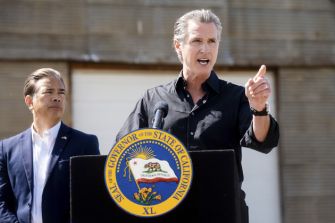California and Governor Newsom Sue Trump in First State Challenge to Tariff Orders Under Emergency Powers

California has filed a federal lawsuit against President Donald Trump over his sweeping imposition of global tariffs, marking the first legal challenge by a U.S. state to the administration’s use of emergency powers in the international trade arena. Governor Gavin Newsom alleges in the complaint that the tariffs are illegal, unconstitutional, and represent a dangerous overreach by the executive branch.
The lawsuit, filed in U.S. District Court in California, names as defendants President Trump; Secretary of Homeland Security Kristi Noem; the Department of Homeland Security; Peter R. Flores, Acting Commissioner of U.S. Customs and Border Protection; and the agency itself. It asserts two primary claims: that Trump acted ultra vires—beyond the limits of his statutory authority—and that his actions violated the separation of powers by usurping legislative authority reserved for Congress.
The White House has dismissed the lawsuit, defending the tariffs as necessary in response to a "national emergency that's decimating America's industries.”
According to the complaint, the President launched an “unprecedented tariff regime” under the International Emergency Economic Powers Act (IEEPA), citing ongoing trade deficits as justification for a national emergency declaration. The legal filing describes a rapid and chaotic rollout of tariff measures: a blanket 10% tariff on nearly all imported goods, the introduction of so-called “reciprocal” tariffs on dozens of countries, a temporary 90-day pause, and then a dramatic increase in retaliatory tariffs on Chinese imports to 145%.
The lawsuit argues that invoking IEEPA in this context is unlawful. “Tariffs, however, are not among the numerous actions that IEEPA authorizes the President to take under a declared emergency,” the complaint states. “Indeed, the word ‘tariff’ does not appear in the relevant statute at all. See 50 U.S.C. § 1702.”
IEEPA, enacted in 1977, was designed to allow presidents to regulate commerce in response to extraordinary foreign threats. Plaintiffs assert that no previous administration has used the law to impose tariffs in the nearly 50 years since its passage. The Constitution, they argue, vests the authority to impose tariffs exclusively in Congress. Article I, Section 8, gives the legislative branch power over duties and imposts, and while Congress has delegated limited authority to the executive in specific trade laws, IEEPA is not among them.
Citing Youngstown Sheet & Tube Co. v. Sawyer, 343 U.S. 579 (1952), the complaint underscores that the President’s authority must stem from either a statute or the Constitution. Further support is drawn from Biden v. Nebraska, 600 U.S. 477 (2023), in which the Supreme Court emphasized the need for “clear congressional authorization” for significant executive action.
The plaintiffs contend that Trump circumvented those requirements by issuing more than a dozen executive orders relying solely on IEEPA to impose or adjust tariffs. “The NEA, section 604 of the Trade Act, and section 301 of title 3 do not give presidents any substantive authority to take any actions,” the complaint explains, referring to the National Emergencies Act and related statutes. “The NEA provides a framework for declaring a national emergency but does not itself provide for the President to exercise any authority to take action pursuant to that declaration.”
The complaint further notes that Section 604 is merely a procedural statute requiring periodic updates to the Harmonized Tariff Schedule, while Section 301 of Title 3 allows for the delegation of functions to executive officers—it does not expand presidential authority.
California’s filing argues that the economic fallout from the tariffs has been severe and wide-reaching. “President Trump’s new tariff regime has already had devastating impacts on the economy,” the lawsuit says. It cites plummeting markets, investment freezes, and instability across domestic and global financial sectors. “Hundreds of billions of dollars in market capitalization were wiped out in hours,” the filing states, warning of a potential recession sparked by abrupt and uncoordinated trade measures.
According to the complaint, no president before Trump has used IEEPA to justify tariffs. Since February 1, 2025, he has issued over a dozen executive orders under the statute targeting imports and raising levies without Congressional input.
The state of California, which ranks as the fifth-largest economy in the world and is home to the largest agricultural sector in the United States, claims the tariffs will inflict especially harsh damage. The measures threaten to raise prices on imported food and consumer goods while straining small businesses and manufacturers across the state.
California and Governor Newsom seek declaratory and injunctive relief. The “Prayer for Relief” in the lawsuit requests the following:
- A declaration that President Trump’s tariff orders issued under IEEPA are unlawful and void, as they exceed statutory authority and violate the Constitution’s separation of powers;
- An injunction preventing federal agencies and officers from implementing or enforcing the orders;
- An award of costs, expenses, and attorneys’ fees under the Equal Access to Justice Act, 28 U.S.C. § 2412;
- Any additional relief the court deems appropriate.
The lawsuit draws on the Supreme Court’s recent guidance in Biden v. Nebraska, emphasizing that “a decision of such magnitude and consequence on a matter of earnest and profound debate across the country must rest with Congress itself, or an agency acting pursuant to a clear delegation from that representative body.” The Court concluded that in such cases, the executive must have “clear congressional authorization” to act.
The challenge by California sets the stage for a major constitutional confrontation over the scope of presidential power in trade policy and emergency declarations. If successful, the case could significantly curtail executive authority in future economic policymaking and reassert Congress’s control over tariff powers.

